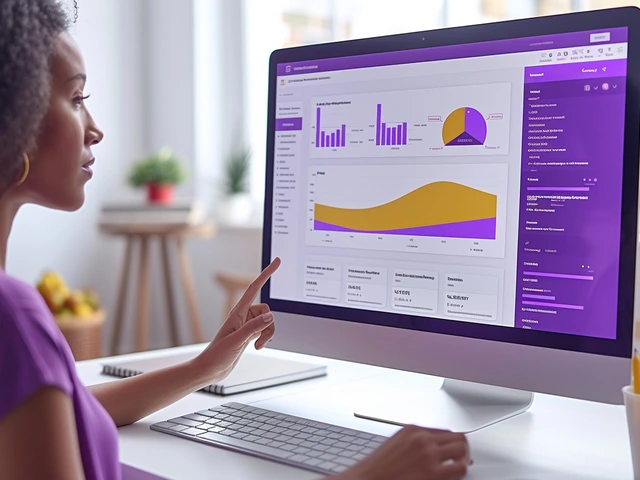Digital Presence Health Check
How's your online presence performing?
Answer 4 simple questions about your digital marketing basics to see where you stand. Based on the four pillars from the article: Visibility, Credibility, Engagement, and Conversion.
Most businesses think having a website is enough to be visible online. But if no one finds you, or if people visit once and never come back, you’re not building an online presence-you’re just wasting hosting fees.
Digital marketing isn’t about posting on Instagram every day or running a Google Ads campaign until your budget runs out. It’s about connecting with real people at the right time, with the right message, on the right platform. And when done right, it turns strangers into customers-and customers into fans.
What Actually Makes an Online Presence Successful?
A successful online presence doesn’t mean having the most followers or the fanciest logo. It means people know who you are, trust you enough to reach out, and choose you over competitors-even when you’re not the cheapest option.
Look at local bakeries in Adelaide. One has 500 Instagram likes and no website. Another has a simple site, clear pricing, real customer reviews, and a Google Business Profile that shows up when someone searches "best sourdough near me." Who gets the Saturday morning rush? The one that made it easy to find, understand, and trust.
Successful online presence is built on four pillars:
- Visibility: People can find you when they search for what you offer.
- Credibility: You look professional, real, and trustworthy.
- Engagement: People interact with you, not just scroll past.
- Conversion: Visitors take action-book a call, sign up, buy something.
Missing even one of these means you’re leaving money on the table.
SEO Isn’t Optional-It’s Your Digital Address
Think of SEO as your online address. If your business isn’t showing up when someone types in "plumber in Adelaide" or "organic skincare for sensitive skin," you might as well be closed.
Google doesn’t care how nice your website looks. It cares about three things: relevance, authority, and user experience.
Relevance means your page actually answers the question someone typed in. If someone searches "how to fix a leaky faucet," and your page is about luxury bathroom design, Google won’t rank you.
Authority comes from other websites linking to you. A local plumbing company in Adelaide that gets linked by the City Council’s website or a popular home improvement blog will rank higher than one with 100 fake backlinks from spammy sites.
User experience? That’s speed, mobile-friendliness, and clear navigation. If your site takes more than 3 seconds to load on a phone, half your visitors will leave. And Google notices.
Start simple: Claim your Google Business Profile. Write clear service pages with real customer questions answered. Get reviews. That’s 80% of local SEO done.
Social Media Isn’t About Posting-It’s About Listening
Posting daily on Facebook or Instagram won’t help if no one is talking back. Social media isn’t a billboard. It’s a conversation.
Look at how a small coffee shop in Norwood uses Instagram. They don’t post filtered shots of lattes. They post videos of their barista explaining why they roast their beans in small batches. They reply to every comment. They ask questions: "What’s your favorite blend?" People start tagging friends. Orders come in through DMs.
That’s engagement. That’s presence.
Here’s what actually works:
- Choose one platform where your customers are-not all of them.
- Post content that solves problems or sparks emotion-not just promotions.
- Respond to comments and DMs within 24 hours.
- Use stories and reels to show behind-the-scenes, not polished ads.
And stop chasing vanity metrics. 10,000 followers who never buy means nothing. 500 followers who comment, share, and ask for your product? That’s your audience.

Email Marketing Still Works-If You Do It Right
People think email is dead. It’s not. It’s the most direct line to your customers.
Here’s the truth: If you’re sending weekly newsletters full of sales pitches, people unsubscribe. But if you send helpful, personal messages-like a quick tip, a real story, or a limited-time offer for loyal readers-you build trust.
A local yoga studio in Glenelg sends a monthly email with one stretch tip, one class schedule update, and a real quote from a student. Open rates? 68%. Unsubscribe rate? Less than 1%.
How to make email work:
- Only collect emails from people who opt in-no buying lists.
- Segment your list: new visitors, past customers, inactive subscribers.
- Send value first, sales second.
- Use a clear subject line: "Your free guide to better sleep (from our yoga teacher)" works better than "Monthly Newsletter!"
Email isn’t about volume. It’s about connection.
Content That Builds Trust, Not Just Traffic
Most businesses create content because they think they have to. They write blog posts they don’t care about, hoping for traffic. It rarely works.
Great content answers a real question someone has right now. It doesn’t try to sell. It helps.
For example, a Melbourne-based home renovation company wrote a guide: "5 Hidden Costs When Renovating a 1970s House in Australia." It wasn’t about their services. It was pure value. They got 12,000 views in three months. 300 people downloaded the free checklist. 47 of them booked a consultation.
Start by asking: What do your customers worry about? What do they search for at 2 a.m. when they can’t sleep?
Answer those questions in simple, honest language. Use real photos. Include mistakes you’ve made. People trust honesty more than perfection.
Tracking What Actually Matters
You can’t improve what you don’t measure. But most businesses track the wrong things.
Don’t care about total website visitors. Care about how many visitors become leads. Don’t care about Instagram likes. Care about how many people message you after seeing a post.
Use free tools:
- Google Analytics 4: Track where visitors come from and what they do.
- Google Search Console: See which search terms bring people to your site.
- Meta Business Suite: See how many people click your Instagram bio link.
Set one goal per month: "Get 20 email sign-ups from our blog," or "Increase consultation bookings by 15% from Google Maps." Then tweak your content or ads until you hit it.
Small wins add up. One extra customer a week is 52 extra customers a year.
The Real Secret? Consistency Over Flash
The biggest mistake businesses make? They go all-in for a month, then disappear. They run a big ad campaign, then stop posting. They send three emails, then go quiet for six months.
Digital marketing isn’t a sprint. It’s a daily habit.
It’s replying to one comment. Updating one product page. Writing one helpful tip. Checking your Google Business Profile for new reviews.
Companies that win online aren’t the ones with the biggest budgets. They’re the ones who show up-regularly, reliably, and with real care.
Start small. Pick one thing: claim your Google profile. Write one blog post answering a common question. Send one email to your best customers. Do it this week. Then do it again next week.
That’s how you build an online presence that lasts.
What’s the first step to building a digital marketing presence?
Start by claiming and optimizing your Google Business Profile. Make sure your name, address, phone number, and business hours are correct. Add real photos, respond to reviews, and post updates. This alone will help you show up in local searches and build trust fast.
Do I need to be on every social media platform?
No. Trying to be everywhere spreads you too thin. Focus on one platform where your customers actually spend time. For B2B? LinkedIn. For local services? Facebook and Instagram. For visual products? Pinterest or TikTok. Pick one, master it, then expand if you have the time.
How long does it take to see results from digital marketing?
Some results come fast-like Google Business Profile updates or a well-timed Facebook ad. But real growth takes time. SEO can take 3-6 months to show strong results. Email lists grow slowly but pay off for years. Digital marketing is a long-term game. Be patient, stay consistent, and track progress monthly.
Is paid advertising necessary for small businesses?
Not always. Many small businesses grow without paid ads by focusing on SEO, content, and word-of-mouth. But paid ads can speed things up-especially for new businesses or seasonal offers. Start small: $5-$10 a day on Facebook or Google can test what works before scaling.
What’s the biggest mistake in digital marketing?
Trying to do everything at once. People jump from TikTok to Google Ads to email campaigns without fixing the basics. A broken website, no reviews, or unclear messaging will ruin even the best ads. Fix your foundation first: your website, your Google profile, and your customer service. Then add marketing layers.
If you’ve been waiting for the perfect time to start digital marketing, that time is now. You don’t need a big team or a huge budget. You just need to show up, be helpful, and keep going.




Write a comment